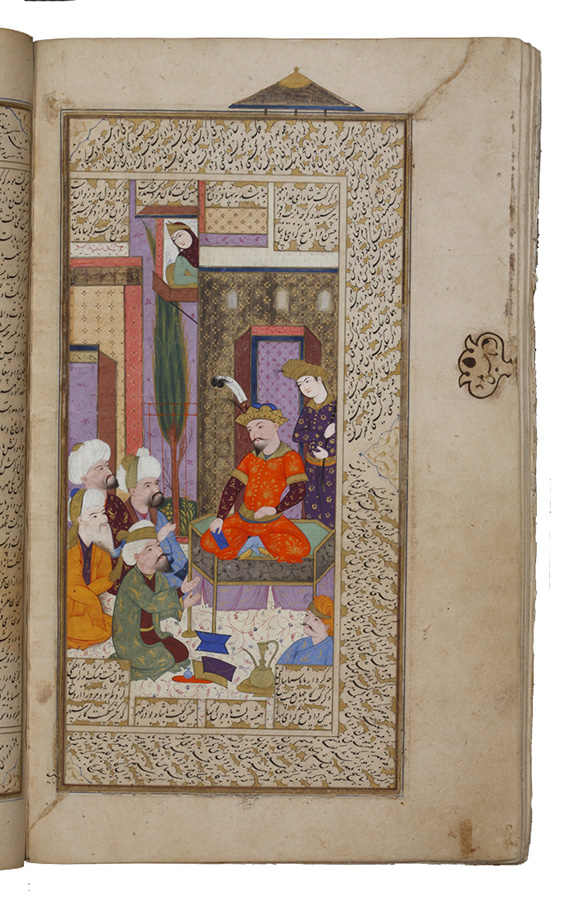Manuscript B, no. 7-388 (David folio 295b)
Anuširavān Enthroned with Buzorjmehr, Who Explains the Game of Chess
Location: The David Collection, Copenhagen, Denmark, #217/2006, folio 295b.
Page: 35.2 x 21.8 cm.
Painting: 21.2 x 11.5 cm. (Scaled)
Text area: 28.6 x 14.3 cm. (Scaled)
Signature in the center of the lower margin: raqam-e kamina moʿin-e moṣavver.
Anuširavān received an embassy from India that brought many opulent gifts, including a chessboard and chessmen. The ambassador said that if Anuširavān could figure out how the game was played, the Indians would pay tribute to Iran, but if he failed, then the Iranians would have to pay tribute to India. Anuširavān handed the game to his sage advisor, Buzorjmehr, who spent a day and a night puzzling over the game until he discovered how to play it.
This illustration appears to depict the moment when Buzorjmehr, in the company of the archmages, explains the game of chess to Anuširavān. Presumably the figure kneeling in the foreground and wearing a green-and-gold robe is Buzorjmehr, who has the tools of a scribe lying beside him. In Anuširavān's hand is a blue sheet, most likely a letter to the Indian king. This setting of Anuširavān's palace is more complex than in other illustrations of interiors in this manuscript. Moreover, the faces of the archmages are more individualized than elsewhere. As mentioned above, one wonders if Moʿin did not include veiled portraits of the patron and his associates here. Without more historical information about Abu'l Mahdi Ḥosayn, one cannot extrapolate a further significance of this particular moment in the text in relation to the patron, but the inclusion of a scene concerned with the efficaciousness of a royal advisor may have referred in a flattering way to the patron. As the penultimate illustration in the manuscript coming from the story of one of the last major kings of pre-Islamic Iran, this painting may have functioned similarly to a finispiece, which could have implied contemporary relevance as well as narrative veracity.
Painting references:
Canby_ Journal_2010, p. 76 no. 41 and p.108, fig.40.
Text references:
Warner, VII, pp.384-88.
Photo: Permille Klemp. Courtesy of The David Collection, Copenhagen
Sheila R. Canby
Last Updated: August 14, 2014 | Originally published: 2010
